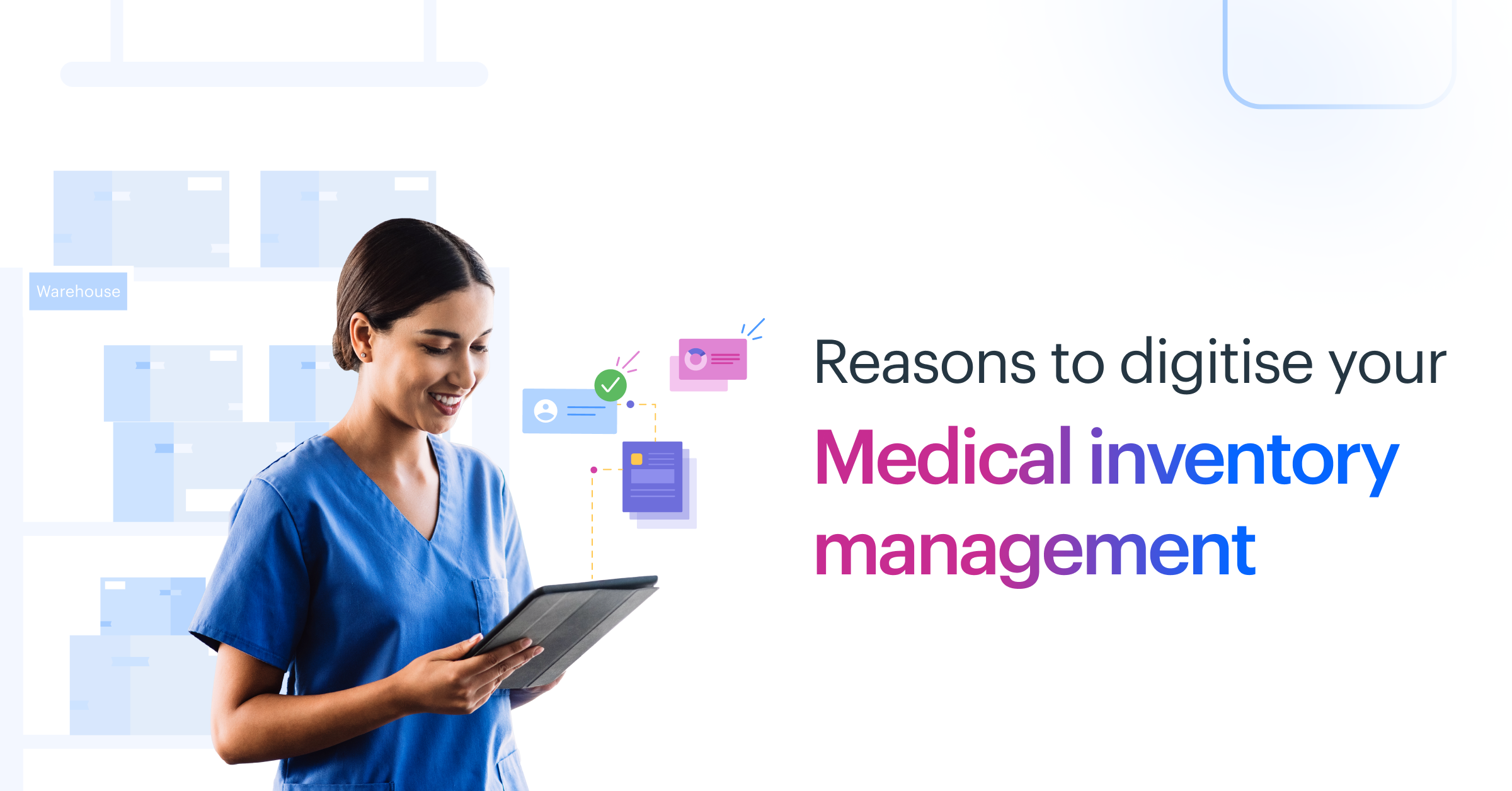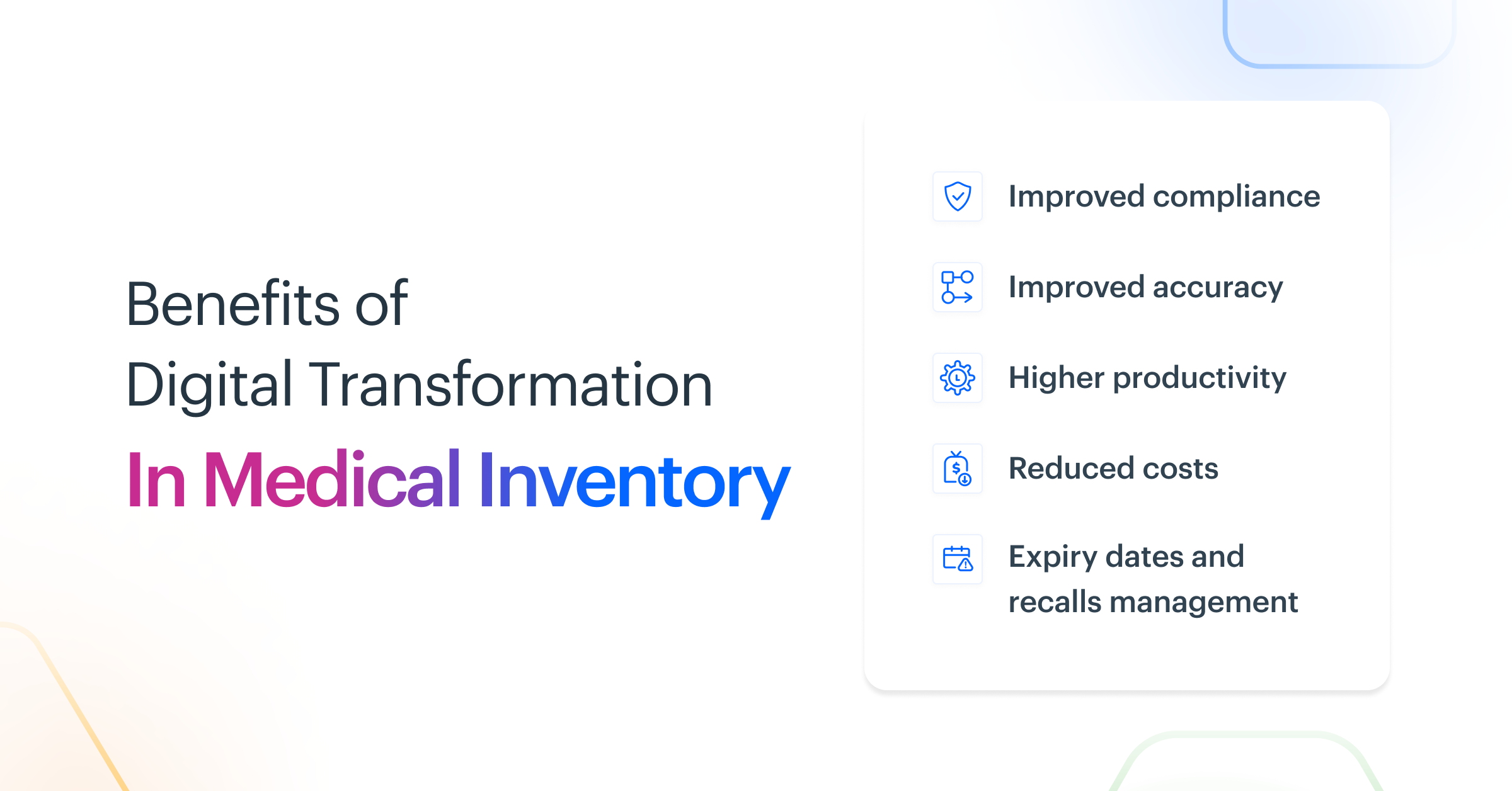The global market value for hospital asset tracking and inventory management systems was $25.28 billion in 2022, and it’s expected to grow at a compound annual growth rate (CAGR) of 6.6 percent to reach $35.16 billion by 2027. This steady growth is driven by the need to improve patient safety and the increasing demand for real-time visibility into inventory levels.
As the fast-paced healthcare industry evolves, so do patients' needs and the cost of medical supplies. Healthcare companies that want to remain competitive must transition from complex and time-consuming inventory management systems to digitized systems.
Medical inventory management software can help healthcare organizations improve accuracy, reduce costs, and enhance patient care. If you're not using a digitized inventory management system, it is time to get one.
Defining digital transformation in medical inventory management

Digital transformation in medical inventory management is all about using digital technologies to improve the efficiency of inventory management. Automated medical inventory management does away with spreadsheets and paper trails. It digitizes internal processes and transforms them into streamlined workflow with the help of automation.
A cloud-based inventory management system allows workers to access inventory data from anywhere and on any device. It's also possible to monitor and track inventory management for multiple locations from the same centralized dashboard.
You can streamline further by putting a unique barcode or dynamic QR code on all inventory items. It becomes easier to scan medical products, improving processing times. Operational bottlenecks are eliminated, and the organization can focus on what matters–its patients!
Challenges and inefficiencies in the current healthcare system
No remote access
Traditional inventory management systems rely heavily on error-prone manual tracking and data entry, which leads to inaccurate inventory levels and stockouts (or overstocking). Also, manual inventory tracking procedures are time-consuming and redundant.
Lack of visibility
Healthcare organizations that use manual inventory management systems have limited visibility into inventory. They have difficulty tracking inventory movement and identifying problems quickly.
Since they rely on manual processes and cannot track inventory well, they can’t forecast demand accurately and quickly lose competitive advantage.
High costs
Maintaining legacy inventory management systems is expensive. As you pile new resources into an outdated system, glitches, bugs, and other issues that need time and money to address may occur. Digital solutions for inventory management can help address these challenges.
Isolated supply chains
Traditional medical inventory management makes it hard to track inventory levels between incoming and outgoing logistics operations. Without real-time reporting, companies have to guess inventory levels, causing overstocking and understocking. A company that can’t control inventory can’t expand and grow quickly. It also has to deal with high logistical costs. This can greatly affect service delivery and patient satisfaction.
Learn more about logistics management software.
Lack of inventory checks
Monthly inventory checks are inefficient because they unveil problems too late. They are also time-consuming because hospital staff must set aside time to compare physical inventory to the system specifics. And oftentimes, inventory checks don’t lead to higher costs and inefficiencies. An automated inventory management system performs checks more regularly, ensuring healthcare companies catch problems early.
The role of technology in improving inventory management
As healthcare organizations face mounting pressure to cut costs and enhance operational efficiency, they’ve recognized the need to leverage technology in inventory management. Technology streamlines processes such as inventory checks and stock reordering and eliminates the need for human intervention.
Additionally, an inventory management system provides real-time visibility into inventory levels, allowing healthcare organizations to monitor stock levels at any moment.In addition to barcode scanning, healthcare organizations can utilize QR code for files to simplify access to essential documents and digitize the inventory management process further. This facilitates seamless updates and reduces the risk of errors, ensuring critical medical information is always up-to-date and readily accessible by staff. Medical professionals can make informed decisions regarding inventory replenishment and allocation, ensuring that essential supplies and equipment for medical device testing are readily available when needed. Chances of running out of stock or having excessive inventory are significantly reduced, leading to inventory optimization and cost reduction.
Technology also improves inventory management through predictive analytics. A medical inventory management system can analyze historical data and use advanced algorithms to help organizations predict future supply and demand patterns. Additionally, in the healthcare sector, advancements in technology have facilitated medical data mining, enabling the analysis of vast amounts of patient information to uncover insights, trends, and patterns that can inform decision-making processes and improve patient care.
Advantages of Digital Transformation in Medical Inventories
The benefits of implementing digital transformation in inventory management are as follows:

Better management of expiry dates and recalls
Using an expired or recalled item can jeopardize patient safety and result in costly litigation. And even if expired items are identified and disposed of, the wasted stock can lead to unnecessary financial loss.
Digital transforming this process can simplify stock rotation by pushing out the soonest-to-expire products first and significantly decreasing the number of expired items that would have otherwise gone to waste.
Improved compliance
Every hospital must meet specific regulatory and compliance requirements, like the FDA’s UDI regulations. They must capture complete data, which isn’t always a straightforward process. Some hospitals rely on manual entry, and others use barcode scanning, but scanning products with multiple barcodes can be confusing.
An inventory management system can monitor dispensing patterns, provide real-time tracking, and generate reports for auditing purposes. Hospitals and pharmacies can meet all regulatory requirements and avoid fines and penalties for non-compliance.
Improved accuracy
A digital inventory management system provides real-time updates and automated tracking, ensuring precise inventory records. It monitors each product that enters and exits the facility. And because it can integrate with other business processes, like a point-of-sale system, it can update inventory levels in real-time and send alerts about decreased inventory. By doing so, it can help reduce internal inventory management costs.
Reduced costs
An inventory management system reduces company costs by preventing overstocking. Some healthcare companies keep their inventory in rented or leased storage space, and overstocking can quickly drive up costs. Also, a company with a good inventory management system can guarantee sales orders and prevent backorders.
Higher productivity
When there are fewer inventory errors to address, employees can do more work in a day. Even when there are constant changes to supply and demand that affect stock levels, a company can sidestep the risks of human errors with automated processes. Employees can focus on other tasks that improve the organization’s bottom line.
How Kissflow helps improve medical inventory management
Kissflow’s inventory management software streamlines processes and integrates easily with other healthcare systems. Unlock operational efficiency in your healthcare establishment with Kissflow today. No coding experience is required.
You just need a good understan
ding of the inventory management process you want to automate. Get complete visibility into inventory levels, keep track of your stock levels, and set up alerts to trigger re-ordering when stock levels drop.














